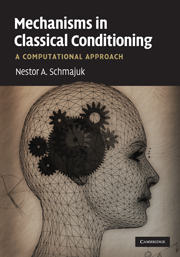Book contents
- Frontmatter
- Contents
- Preface
- Acknowledgments
- Abbreviations
- Part I Introduction
- Part II Attentional and associative mechanisms
- 2 An attentional–associative model of conditioning
- 3 Simple and compound conditioning
- 4 The neurobiology of fear conditioning
- 5 Latent inhibition
- 6 The neurobiology of latent inhibition
- 7 Creativity
- 8 Overshadowing and blocking
- 9 Extinction
- 10 The neurobiology of extinction
- Part III Configural mechanisms
- Part IV Attentional, associative, configural and timing mechanisms
- Part V Conclusion: mechanisms of classical conditioning
- References
- Author Index
- Subject Index
7 - Creativity
from Part II - Attentional and associative mechanisms
Published online by Cambridge University Press: 23 May 2010
- Frontmatter
- Contents
- Preface
- Acknowledgments
- Abbreviations
- Part I Introduction
- Part II Attentional and associative mechanisms
- 2 An attentional–associative model of conditioning
- 3 Simple and compound conditioning
- 4 The neurobiology of fear conditioning
- 5 Latent inhibition
- 6 The neurobiology of latent inhibition
- 7 Creativity
- 8 Overshadowing and blocking
- 9 Extinction
- 10 The neurobiology of extinction
- Part III Configural mechanisms
- Part IV Attentional, associative, configural and timing mechanisms
- Part V Conclusion: mechanisms of classical conditioning
- References
- Author Index
- Subject Index
Summary
In this chapter, we apply the SLG model presented in Chapter 2 to the theoretical analysis of creativity. Creativity can be defined as a psychological process that produces original and appropriate ideas. A rather large number of theories have been proposed to account for this process, including Guilford's (1950) psychometric theory, Wertheimer's (1959) Gestalt theory, Mednick's (1962) and Eysenck's (1995) associative theories, Campbell's (1960) Darwinian theory, Amabile's (1983) social–psychological theory, Sternberg and Lubart's (1995) investment theory, and Martindale's (1995) cognitive theory. Other approaches, such as artificial intelligence models (Boden, 1999; Partridge & Rowe, 2002) also contribute to our understanding of creativity.
Mednick (1962) defined creative thinking as the combination of different associations. This combination might result from (a) contiguity, the accidental or planned temporal proximity between the elements of the association; (b) generalization, the sharing of common factors by the elements of the association; or (c) mediation, the simultaneous activation of both elements of the association. Mednick suggested that differences in creativity depend on the strength of the associations that enter in the combinations. In a similar vein, Eysenck's (1995, page 81) theory stipulates that (a) cognition requires associations, (b) differences in intelligence depend on the speed to build these associations, (c) differences in creativity depend on the range of associations considered in problem solving, and (d) a comparator is needed to eliminate wrong solutions.
- Type
- Chapter
- Information
- Mechanisms in Classical ConditioningA Computational Approach, pp. 119 - 136Publisher: Cambridge University PressPrint publication year: 2010

